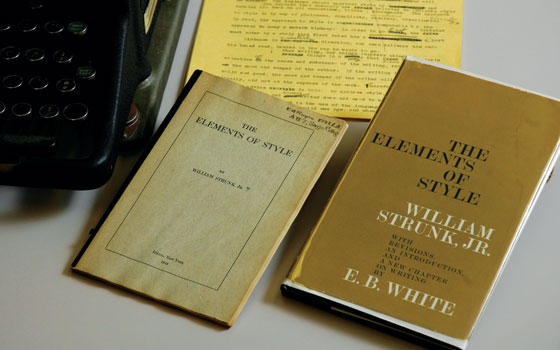A Little History of the Little Book
A version of this blog post appeared in abridged form on Polaris and in the Hamilton College Spectator on February 13, 2004.
We pass the building every day, yet most of us have been inside only once. Upon matriculation, we entered Kirkland Cottage to sign the College Register. An administrator then gave us each a copy of The Elements of Style by William Strunk Jr. and E.B. White, a practice that began in 1999. With Hamilton’s commitment to a “writing-intensive experience,” this “little book,” as Strunk sardonically called it, unites all Hamiltonians; so shouldn’t we know more about it? Here’s a little history:
In 1918, as mandatory reading for the fall semester of his English 8 course at Cornell University, Professor William Strunk Jr. copyrighted and privately published in Ithaca, New York, a textbook titled The Elements of Style. Arguing that one must first know the rules before breaking them, Strunk intended his reference book “for use in English courses in which the practice of composition is combined with the study of literature.”
In 1919 Strunk reprinted The Elements for the spring and fall semesters of that year’s course, in which one Elwyn Brooks White was a pupil. The next year, Strunk had his textbook published, by Harcourt Brace and Company, as a 52-page book; this is often called the “first trade edition.” In 1935, two years before Strunk ended his 46-year tenure at Cornell, one of his sons, Oliver, copyrighted a “revised edition” of The Elements by William Strunk Jr. and Edward A. Tenney. (A search on Amazon.com reveals nothing about Tenney.)
Strunk died in 1946. In early 1957, H.A. Stevenson, editor of the Cornell Alumni News, filched from the campus library one of its two remaining copies of The Elements and mailed it to a longtime friend, E.B. White. Seeing the book again inspired White to write an affectionate piece about his late professor for the New Yorker. An editor at the Macmillan Company, J.G. Case, spotted the article and asked White if he’d like to revive the book.
Case’s original proposition was to use White’s essay as an introduction, but the project expanded and White revised the text as well. According to Letters of E.B. White, Case commissioned several grammarians well versed in the textbook field to submit suggestions to White. No doubt, Strunk would have applauded his co-author’s retort: “If the White-Strunk opus has any virtue, any hope of circulation, it lies in our keeping its edges sharp and clear, not in rounding them off cleverly. . . . Any attempt to tamper with this prickly design will get nobody nowhere fast.”
Thus was born The Elements of Style, with Revisions, an Introduction, and a New Chapter on Writing by E.B. White (1959).
In 1972, White published a second revision with the help of Eleanor Gould Packard. A longtime copy editor and authority on grammar and style at the New Yorker, Miss Gould had bought a copy of The Elements when it first appeared, marked it up as she would mark a raw proof, and slid it into a drawer of her desk. White knew nothing about this—Miss Gould was too shy to admit doing it—but later, when The Elements was up for revision, White asked for her help. She agreed, and revealed that she had in her possession a marked-up first edition.
In 1979 White published a third edition, which included an index prepared by Lieutenant Colonel Laurence W. Mazzeno of the United States Naval Academy.
White died on October 1, 1985, but The Elements of Style lives on, published in hardcover and paperback by Allyn and Bacon. For the “modestly updated” fourth edition, Roger Angell, E.B. White’s stepson and also a New Yorker staff writer, wrote the foreword; Charles Osgood, who also produced a video called The Elements of Style Video, wrote the afterward; and Robert DiYanni furnished a glossary. The book remains, as The Chicago Manual of Style puts it, a pithy “classic that offers excellent practical advice.”

 Comments
Comments